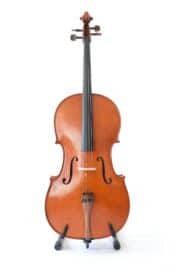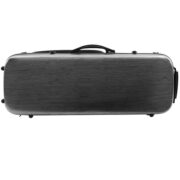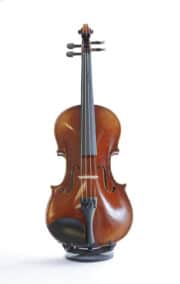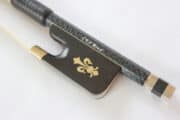 Just arrived! Austin Electric Violins in Black or Red. $449 includes case, bow, headphones. Solid wood body with pre-amp – Listen through the headphones with no AMP necessary! It has 1/8″ jacks on the back for Headphones, Output and Mic. This outfit will make a fantastic gift!
Just arrived! Austin Electric Violins in Black or Red. $449 includes case, bow, headphones. Solid wood body with pre-amp – Listen through the headphones with no AMP necessary! It has 1/8″ jacks on the back for Headphones, Output and Mic. This outfit will make a fantastic gift!
Austin 4/4 Electric Violin with case, bow, headphones and built-in pre-amp
Meteny Violin by Pascal Gilis
Currently we have a special violin in the shop. We just received a very fine violin that was built by the Romanian maker Pascal Gilis. Now living in Brussels, this maker delivers an instrument that is an instant classic with the right look, feel and sound that will make it someones “forever” instrument. The tone is rich and even with an ability to produce volume at the touch of the bow. The a Asking price for this violin is $7,000. SOLD
Welcome to Keller Strings!
Keller Strings is a transplanted musical instrument store from the Midwest region of the country. We facilitate a rapport with both new and experienced musicians who place high value on customer service and convenience while maintaining a combination of timeless charm and New Orleans’ laissez-faire sensibility.
We believe in old fashioned customer service which is the foundation of Keller Strings, a boutique violin shop specializing in select European violin family instruments, bows, and accessories. We have been doing this for a long time and there is nothing we haven’t seen and no problem we cannot solve. You can call us experts, but we’re just happy to help. It is about finding you a handcrafted instrument (old or new) that your family will enjoy for generations.
Keller Strings knows that instruments are nothing without the people behind them. If there are two things we love most, it’s live music and being a part of the community that makes it happen. Because of its rich music history, deep culture, and passionate artistry, New Orleans provides us with the perfect backdrop for our beautiful, artisanal string instruments.
New Orleans has inspiring rebirth
by George Gurley, for the Lawrence Journal-World.
The preacher in New Orleans last Easter drew a parallel between the Resurrection and the rebirth of the city after Hurricane Katrina. Outside, it was a beautiful spring day — birds singing, trees leafing out, fragrance of flowers in bloom, Easter bonnets everywhere. But the preacher remembered the dark days when the streets of the city were patrolled by National Guard troops in Humvees, when many gave New Orleans up for dead. She recalled going into a shop in Baton Rouge, where she’d been evacuated, and seeing bins filled with banners that proclaimed, “Open.” What were they for? she asked. The banners were for anyone who was brave enough to return to New Orleans, the proprietor said.
When she got back, she found a “Condemned” sign in front of her church. The colossal steeple had fallen on the roof. Damages were estimated at $5 million. It would have been tempting to fall into despair. But next to the “Condemned” sign she put up an “Open” sign. Take that, Katrina. Since then, the church had been completely restored. The pews were filled with cheerful families on Easter Sunday. It was a happy scene.
The preacher delivered a sermon to the children on the subject of losers — people like Albert Einstein, Walt Disney and Michael Jordan who were written off as failures when they were kids. Don’t give up if you ever feel like a loser, she said. You can do anything you put your mind and heart to. She quoted Walter Percy’s wonderful saying: “Everything will be all right in the end. And if it’s not all right, it’s not the end.”
The preacher could have passed for a soccer mom cheering her kids or a coach exhorting her team. Buckle down. We can win this thing. She was no Pollyanna. There were none of the weary platitudes that issue so often from the pulpits these days. One moment she was colloquial — the Resurrection was a “game-changer,” she said. The next moment she was a revival orator, exhorting the congregation to “rise up,” defy the odds, live in determined hope rather than in fear of death.
A few years ago my daughter and her husband moved to New Orleans and have thrown themselves into the life of the festive city, marching in Mardi Gras dressed as an alligator and an egret, staging crawdad boils on their driveway, canoeing the local bayous. A “second line” parade passes by and out the door they go to join in for a mile or two. New Orleans was recently named the best food city in the nation by Saveur magazine. It may also be the best music city. Grammy-winning bands play in no-cover dives. Walk down any street and you’re likely to hear music floating from a second-story window, someone warming up for a session that night.
New Orleans is like no other city in the country. The minute you step onto the street you sense a unique spirit — spontaneity, a passion for the moment. Where else can you find streets named Humanity, Pleasant, Elysian Fields, Desire? New Orleans is endless celebration. (Special trucks appear in the morning spraying lemon-scented water to clean the streets of excesses from the night before.) By the way, to establish your credentials as an insider, you much be able to pronounce the name of another street – Tchoupitoulas (Chop-a-too-less).
It must also be said that it’s not that unusual to hear gunshots or see young men chasing down the street with pistols in their hands. Crime is still out of control. “Thou shalt not kill” signs adorn the yards. New Orleans still has its share of problems. But it’s enjoying its own springtime of rebirth. On every block you can see houses undergoing restoration. The dysfunctional educational system has been rebuilt from scratch and dramatically improved. Talented young people are flocking to New Orleans, drawn by opportunities and challenges.
“Katrina created the opening for different policies to turn around what was one of the worst-run and most politically calicified places in America,” according to a recent editorial. No one would wish for a catastrophe like Katrina. And yet disaster can clear out the dead wood of vested interests and sclerotic institutions. The same could be said for individuals — we fall into comfortable ruts. Our finest hours sometimes come when we’re forced to wake up and change.
Perhaps there’s a lesson for Lawrence here.
“We can’t just rest on our laurels,” said the head of the Lawrence Chamber of Commerce recently. Laurels? It seemed a strange choice of words on the occasion of Lawrence’s spectacular nosedive to “the second-worst performing small metropolitan area in the country,” according to a national study. On top of that, the town had a mediocre showing in an education report. Perhaps this is Lawrence’s wake up call. Time to ask big questions: How did this happen? What’s to be done?
David Hopf Repair
September 16, 2009
Mr. Wheetman:
RE: Repair to David Hopf violin by Keller Strings.
The following is a description of restoration completed and impressions of prior repairs.
After the top was removed, we discovered many open old cracks. A row of thin maple had been added to create a wider rib. When this was done, there was too much material in several places causing the top to bulge and twist, particularly at the bottom bout where the saddle sits and on the upper left (E) bout. An older repair included several large tall and bulky cleats to the top cracks. We cleaned all of the open cracks (approx. 8) and removed some of the tall cleats; reshaped and replaced them. New cleats were added to reinforce. The base bar crack was open at the lower 3 inches. The old patch was removed and three L cleats were added to reinforce this crack. Clear spirit varnish was added over the repaired cracks for protection.
No additional work was needed to the back cracks and previous cleats were left untouched although some were thinned.
The edge of the top on the lower bout on the G side was missing so a new edge was carved and installed.
Since the scroll box showed many older repairs including peg bushings, the decision was made to reinforce the interior of the box with 1 ½ mm thick maple. Any further damage to the box will most likely require the replacement of the scroll and peg box with a scroll graft. The shape and size of the existing peg holes was not changed. The decision to replace the pegs was made as the old pegs were worn and too short.
French polish was added for appearance and more protection to the varnish.
Paula Keller Smith
John W. Smith
Emergency Seam Repair Made Easy
Well, there you are! You’ve made it to Carnegie Hall, or Preservation Hall. Maybe your instructor mentioned that it might be better if you practiced in the hall…in a different building….
You know that your instrument used to sound better than that. It used to be clear as a bell. Now you are hearing that annoying buzz. It isn’t always there; only on certain notes and only then if you’re really leaning in to it, or perhaps playing quietly to yourself. The circumstance will almost always be different, but the cause is nearly always the same: a loose seam, or a separation in the spot where the fingerboard extends from the neck.
Orchestral stringed instruments are assembled using natural hide glue that is heated just before use. The common and accepted materials for these instruments are Spruce for the top plate and Maple for the sides, back and neck. The fingerboard is generally Ebony. Over time, with the expansion and contraction of the upper plate (top) of the instrument which is different than the sides and back, the glue can release in one of the seams. This is a good thing, because if there is a stress point and the glue didn’t release, it could cause a crack to open in one of the surfaces.
There you are, thirty minutes to curtain and your nemesis the buzz has reared its ugly head. If you can locate the opening by pulling very gently on the seams, watching for the shadow of a gap (be very careful when doing this on the C-bout tips, or they’ll snap off) then the seam can be re-affixed using nothing more than a little hot water, the chinrest and a paper clip with one loop straightened. This will be a temporary fix until you can get your instrument in to the shop for a proper checkup.
First remove the chinrest from the instrument using the straightened paper clip (or chinrest key). Be very careful not to push the paperclip so far through the chinrest turnbuckle that you scratch the rib with the end. The chinrest will become the gluing clamp for your repair.
Using whatever you can find (something thin but not sharp) drip a little hot water in to the open seam. Move the seam a little to help work the water in to the space, and then quickly attach the chinrest to the instrument being careful not to over tighten the turnbuckles. It won’t take much pressure. A good sign is if a little water is pushed back out as it is tightened. If needed wipe the edge with a cotton cloth. Leave clamped as long as you have time for (the longer the better).
When you remove the clamp, try to resist the temptation to give the spot a little tug to find out if it is holding. You could easily pop it back open. This quick fix will stand a decent chance of holding until you can get it in to Keller Strings for the proper attention it deserves.
When Bad Things Happen to Better Bows
Several years ago one of our customers was telling me about an incident that had occurred many years earlier. He was playing with a cherished bow given to him by musician John Denver. As can sometimes happen, the bow flew out of his hands and sailed tip first straight to the stage floor and broke. He kept the bow (both pieces), wondering if or how it could ever be fixed.
Once the tale had been told, I asked him if I could take a look at it.
When a bow is broken off close to the head without leaving any damage to the head of the bow itself, it can be an issue to decide which way to go with a repair. The first repair option would be a head splice in which the broken ends are brought together with the strongest glue. Then a thin saw blade is used to cut a slot lengthwise through the repair joint and through the upper part of the bow head. After cutting, a strip of hardwood veneer or Pernambuco Wood is inserted. This is a difficult repair as the slenderness of a high quality bow stick needs support and to be very stable while cutting and inserting. If this repair were to go poorly, or wasn’t an option, there is another method of restoration. A graft is made from the tip end portion from another bow (around six to eight inches long). I always prefer the first method as it should preserve the weight and balance of the bow. Once complete, the repair should disappear with the correct stain and French polish. This repair starts at $70, plus the cost of a re-hair, so you are looking at a minimum of $130.
This story is not unusual, and it seems common that musicians do not believe that a break of this type can be fixed. The cost of more time-consuming repairs—such as reattaching the head, replacing the tip, or restoring a crumbling frog, can soon overtake the value of most bows. Also, some kinds of damage devalue a bow so much that it may not make financial sense to undertake expensive repairs. On the other hand, if you love the bow for its qualities and repairing can make it playable again, then it may well be worth the price. You should consult Keller Strings to help you make a sensible decision.

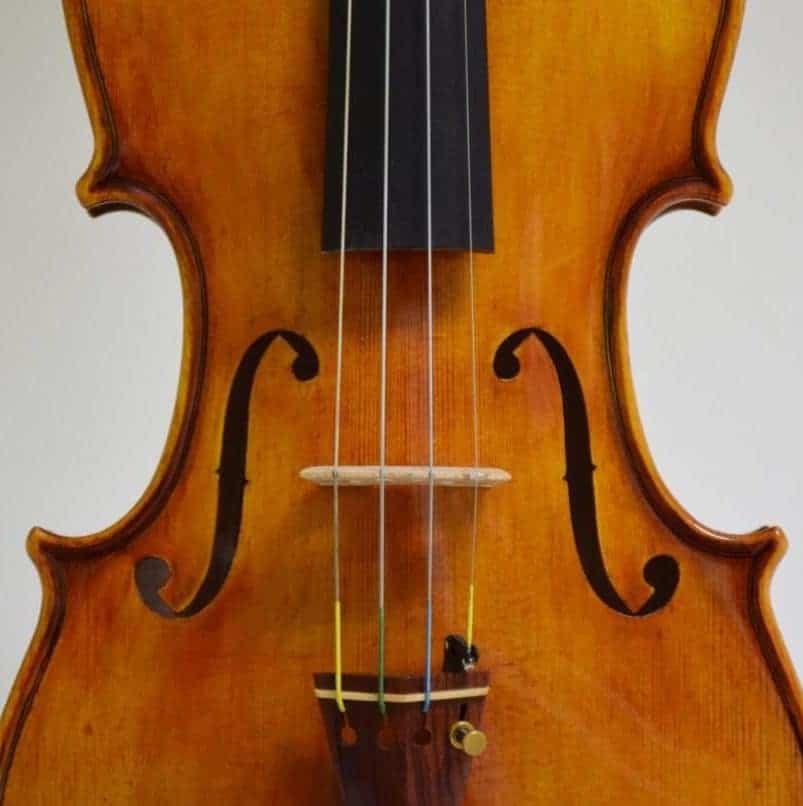 Visit our online store for great finds!
Visit our online store for great finds!
